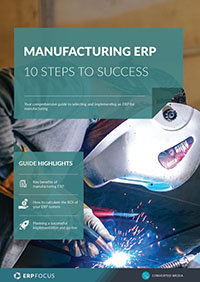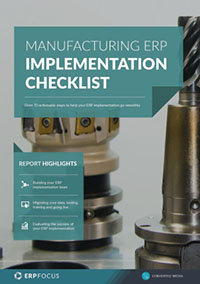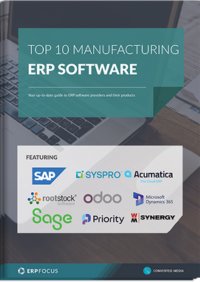Process manufacturing ERP: formulas and recipes
Process manufacturers transform materials into completely new products. They convert agricultural products and chemicals into intermediate products, and for final consumption. Unlike a discrete manufacturer’s products, those of a process manufacturer can never be converted back to their original state.
Managing recipes and formulas is vital for process manufacturers. It's an ongoing task as new ingredients emerge or existing ones change. Food processors continually need to reduce costs. Pharmaceutical businesses must deal with changes to compliance rules. Chemical producers must manage environmental concerns. So what do you need from your process manufacturing ERP system to manage these changes efficiently and meticulously?
A requirement common to all process manufacturers is the need for reconfigurability in the formulation management module. ERP systems for manufacturing processes must be able to use both volume and weight for recipe ingredient management and reporting.
In food production, for instance, the ingredients might be in weight as they are added to the process, but nutritional information regulations require reporting of the same ingredients on the label by volume. This reconfigurability is also vital in global manufacturers who must switch between units of measurement to accommodate local expectations.
Formulas and recipes
A formula consists of ingredients and quantities needed to produce a specific quantity of some product. The formula includes processing steps and processing time required to produce that same quantity.
Your formulations rely on nominal quantities for a standard output. If material shortages are common in your industry, your ERP system should adjust formulations based on available materials to predict yield. This yield would then need to be fed into your inventory and sales module in real time to avoid any backorders.
Each ingredient can scale in different ways as the production quantity changes. Some ingredients will double as the production quantity changes from 10 to 20 units of output. Another ingredient is required in a single quantity regardless of the expected output. Think of yeast when baking bread. That little package is all you need whether baking a single loaf or a dozen loaves.
The requirement for scaling is especially important. You might have a demand for 100,000 Kg. You do not want an ERP that only allows production in batches of 40,000 Kg., as you will be over or short of demand by a significant quantity. True demand should rule and not some artificial limit imposed by your ERP system.
Along a similar line to material shortages, many recipes and formulations stored in ERP must also cope with material substitutions. A drug might not permit substitutions for a component that must come from a certain manufacturer. Another chemical could be switched between two or three different suppliers with no change to the formulation. Still, another might allow a substitution, but only if the quantity required is increased and another reagent is substituted.
Check out the top process manufacturing ERP systems with our free guide
By-products
ERP systems also have to deal with by-products. You are making product A, but halfway through the process, you drain off unnecessary liquid. There is a market for that liquid so it is not waste but a product B you can sell on the side.
The expected output from a production job usually will include a positive quantity of product A and a negative quantity of product B (which signifies you are moving a quantity of that product back to inventory after the job is complete) and an ERP system for a process manufacturer will meet that requirement.
Co-products
Process manufacturers often deal with co-products, which can either be secondary items or other products created using the same ingredients and manufacturing process. These co-products are considered expected outputs of the production process.
Catchweight
Catchweight originates with the fishing industry. A ship returning from the fishery will have a known weight of fish and a cannery or other food processor will buy that weight. Only after sorting will the exact weight of several kinds of fish be known and only after processing will we know the weight of the actual useful yield of those fish separated from the bone and other scrap.
The same phenomenon is frequently found in many types of food processing. Someone buys a truckload of steers based on the gross minus tare of the trailer. Later we learn the weight of meat those steers will yield.
Compliance
Compliance is an important requirement for all businesses today including those who use process manufacturing.
CGMP, or current good manufacturing practices, is a critical measure of whether an ERP is suited for process manufacturers. The business’ quality management systems define their good manufacturing practices and the formulas and recipes captured in the ERP control whether production work will be used for those jobs. Further, when employees capture their time, and as ingredients are issued to those jobs, the actual time and materials used can easily be compared to the CGMP standards within those jobs.
HACCP, or hazard analysis and critical control points, is a preventative approach to guard against and control biological, chemical, and physical hazards from procurement, handling, and production through manufacturing, distribution, and consumption of products.
These safeties relate particularly to process manufacturers. Those critical control points should be documented in the process flow component of formulas and recipes. At each point, an appropriate measurement should be made and recorded in the ERP system ensuring that many HACCP requirements are met.
Process manufacturers need to track ingredient materials, intermediate, and final production items using lot numbers for necessary tracking. When an item is added to inventory, a lot number is assigned.
This lot number stays with the item through subsequent production jobs or sales. If issues arise, the manufacturer can trace back through ingredient lots used in production to identify any potential concerns.
Find the top manufacturing ERP modules using our free guide
Products often need to disclose ingredient proportions as a percentage of the final product. This calculation is straightforward when both use the same unit of measurement, like milligrams and ounces. How do you calculate the percentage when the final product is measured in milligrams and the ingredient in a volume measurement such as liters?
What about when the liquid is consumed during production by evaporation or a chemical reaction? This situation is common and process manufacturing ERP systems must be able to reconcile a wide variety of situations when the formula and recipe use different units of measurement.
Product grades
Certain products from process manufacturers may result in varying grades in the final products. The formula or recipe may be the same, and the processes involved appear similar, but since the ingredients are organic, the outcomes are influenced by Mother Nature rather than solely the manufacturer.
The highest-grade yield sells for the highest margin and has the most customer demand. However, lower-grade yields also can be sold profitably. If your products yield different grades, be certain the ERP you choose can adequately handle your requirements.
Shelf life
Process manufacturers need to control shelf life at the final product and ingredient levels. Compliance mandates the inclusion of use-by or best-consumed-by-date labels on products. The ERP system derives this date from manufacturing process steps and ingredient age, both linked to the formula or recipe.
Ingredient shelf life usually is related to the procurement date of the ingredient. ERP should capture the procurement date and track the usage of the ingredient. A stale ingredient should not be used at any time in production and the manufacturer will normally manage inventory to schedule use well ahead of the shelf life expiration date. In cases where there is no demand, the manufacturer will know to dispose of that ingredient from inventory well ahead of any time when its use will be a problem.
Reasons to change a formula
Once you have a formula or recipe that yields the desired product many would say, “Leave well enough alone”. However, that is not always possible, or even necessarily the best course of action. Some ingredients might become unavailable unexpectedly or become too costly due to conditions beyond the manufacturer’s control.
Process manufacturers have the same pressures as any business to constantly reduce costs. If a lower-priced ingredient becomes available, there is a good reason to change the recipe. The process itself might be changed which means the formula will change. Perhaps someone finds a way to reduce mixing time or the business decides to purchase a new mixer that reduces the necessary time. Once the revised process is defined and documented, update the ERP system to lock in the improvement.
Altering a recipe or formula is a significant task, requiring thorough testing to maintain the product's integrity and meet customer needs and compliance standards. Engineers may be attached to their formula and reluctant to change, despite the reasons. Your business must assess if the benefits justify the risks before retesting the revised formula for approval.
Lot traceability
A crucial ERP feature for process manufacturers is lot number tracking. Backward lot traceability enables tracing ingredients back to the supplier's incoming lot when customers inquire about a specific lot they received.
In the case of a food manufacturer, that means to the field the crop was grown on. Forward lot traceability means that we can start with any incoming supplier lot number in our process manufacturing ERP and know exactly which production lots used which materials and which customers received products containing any of the materials from that supplier lot number.
In some cases, lot traceability may be internal. There might be an interim formulation that is never sold but is later used as an ingredient in one or more downstream production lots.
Lot traceability in process manufacturing ERP is a regulatory requirement for suppliers and customers. The ERP system must flexibly handle various supplier lot number formats. Final sales lot numbers often follow specific internal formats or external regulations. Lot numbers are linked to production job numbers.
Maximizing efficiency, minimizing risk
Many products have a shelf life or an expiration date. That date will be related to specific lots. Particular lot numbers might have specific safety factors that must be provided to customers and be available to regulatory agencies. Those lots will have their own MSDS published.
A lot number can also relate to a manufactured date or the date the ingredients were mixed. An expiration date could relate to a particular ingredient which might be the controlling factor in the product’s life. All these variables affect inventory quality which, in turn, affects the efficiency of the process manufacturing process. With this in mind, these variables should be tightly controlled within your process manufacturing ERP system.
In some cases, a single production lot might be divided into several sales lot numbers. Many products are graded - the best output will have one set of lot numbers and lower-level output will be assigned others. Co-products and by-products will receive their own lots too.
Many process manufacturers' products are hazardous, either initially or due to unexpected reactions. Discovering contamination later is also a risk. Lives are at risk, so disaster potential is real. Financial ruin through lawsuits or penalties is possible even without harm caused. ERP users in process manufacturing must maintain lot traceability and use ERP effectively to reduce risks.
Conclusion
Whichever process manufacturing ERP system you select, formulas and recipes are crucial. They need to be versatile, powerful, and agile to swiftly respond to market changes. Your product quality relies on them, meeting customer expectations. Your ERP must also align with governmental and industry standards.
Even if your customers like your products, any of these third parties can disrupt your operations or even put you out of business. Ensure the ERP you choose both defends the way you make your product and enables you to continue making and improving the products your customers want. Process manufacturing ERP formulas and recipes perform similar work to a discrete ERP bill of material while resolving much more difficult working conditions.
Free white paper
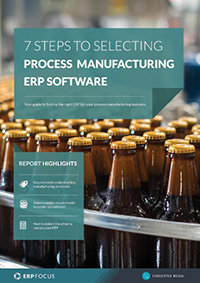
7 Steps to Selecting Process Manufacturing ERP
Your guide to finding the right ERP software for your process manufacturing business
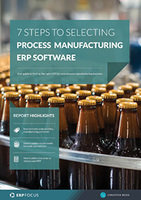
Featured white papers
Related articles
-
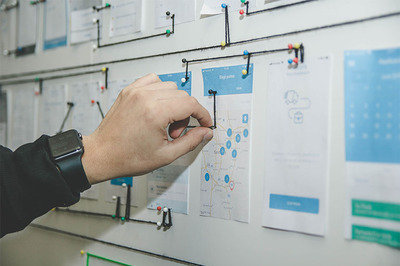
Sales demand forecasting and ERP
How ERP improves your demand forecasting
-

CMMC Compliance: What Aerospace and Defense Manufacturers Need to Know
Key insights on CMMC compliance, deadlines, and securing DoD contracts with CMMC 2.0 certificatio...
-

ERP & Logistics: Optimizing the Supply Chain
Read about the steps you can take to optimize your supply chain through ERP software logistics ma...


